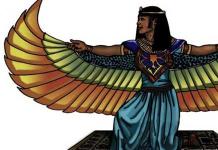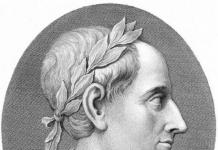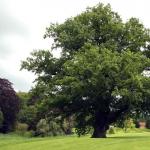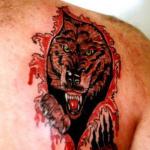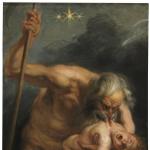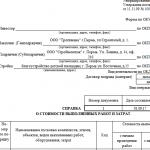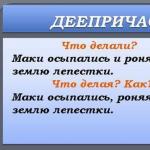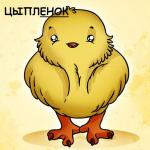; Accordingly, four evangelists are recognized in the Christian tradition - Matthew, Mark, Luke, John.
More precisely, the authorship of the evangelists is of a special kind, not claiming individual authorship in the modern sense of the word, but aiming to convey the message about Jesus Christ and His teaching; it is designated by the specific formula “Gospel of...”, which means “the Gospel, sealed by the authority of such and such,” “received from the lips of such and such” (see Gospel for more details).
Jordaens Four Evangelists.
The Apocalypse of John the Theologian indicates that the first animal was like a lion, the second was like a calf, the third had a human face, and the fourth was “like a flying eagle” (Rev 4:7). The faces in the order in which they are indicated in Ezekiel were correlated with the four evangelists - in the order of the Gospels in the canon - and began to be depicted in Christian iconography (see Icons).
For the first time such an image was recorded on a mosaic in the Church of St. Pudentians in Rome (early 5th century). Gradually, a certain iconographic canon was developed: if the symbols of the four evangelists were depicted in one row, then the artists adhered to the order of the Gospels as part of the New Testament, that is, they depicted sequentially an angel, a lion, a calf (bull) and an eagle; if the symbols were placed in the four corners of an icon, fresco, painting, miniature, then in the top row on the left was an angel, on the right - an eagle (as symbols of the celestial spheres), and in the bottom row on the left - a lion, on the right - a Taurus (as symbols of the earthly world) .
Further, in the Middle Ages, in the four animals and their faces they saw symbolism associated with Jesus Christ himself: being a man in all its fullness and at the same time carrying in Himself the fullness of the spiritual nature (angel), He was sacrificed as a sacrificial animal (calf), then rose up like a lion and ascended to heaven like an eagle.
G. V. Sinilo
Evangelist symbols: Leo, Taurus, Angel, Eagle
Symbols of the evangelists - symbolic images of the four evangelists in the form of creatures: Matthew in the form of an angel, Mark in the form of a lion, Luke in the form of a calf, John in the form of an eagle. Each one is winged and holds the Gospel. The source of the symbols can be found in the Old Testament prophecy of Ezekiel (Ezekiel 1).
Since 1722, by decree of the Synod, it has been prohibited to depict evangelists directly in the form of animals. The symbols of the evangelists could only accompany images in human form. Symbolic images remained in Old Believer iconography.
The Old Believers are characterized by a different, more ancient on Russian soil, identification of symbols with the evangelists: John is symbolized by a lion, Mark by an eagle, Matthew by an angel, Luke by a calf. This interpretation of Ezekiel's prophecy goes back to Irenaeus of Lyons.

| The source for this image was quotes from the Book of the Prophet Ezekiel and the Revelation of John the Theologian: And I saw, and behold, a stormy wind came from the north, a great cloud and swirling fire, and a radiance around it, and from the middle of it, as it were, the light of a flame from the middle of the fire ; and from the middle of it one could see the likeness of four living creatures... and each had four faces, and each of them had four wings... and they sparkled like shiny copper... The likeness of their faces was the face of a man and the face of a lion on the right side of all four of them; and on the left side - the face of a calf in all four and the face of an eagle in all four. Ezekiel 1:4-10 And the first living creature was like a lion, and the second living creature was like a calf, and the third living creature had a face like a man, and the fourth living creature was like a flying eagle. Rev 4:7 Initially, the evangelists identified with the four cherubim (throne angels of the Lord), but from the 5th century. they were replaced by tetramorphism. This four-facedness comes from ancient Eastern ideas about the guardians of the four corners of the world holding the firmament, which in turn are based on zodiacal symbols. Irenaeus of Lyons (c. 180) compared the evangelists, based on their ideal properties, with a four-faced creature, without characterizing each individually, but paying attention to the specific impact of the gospel:
Jerome (c. 348-420) motivates it this way:
Subsequently, the four evangelists were placed side by side with other groups of the same size. For example, in the texts there is a comparison of the Gospels with the four rivers of paradise. Undoubtedly, we are talking about a specific personifying embodiment of majesty, power, strength and insight and aspiration based on ancient motives and traditions. Their correlation with the four main virtues - wisdom, fearlessness, prudence and justice - is also ancient. G. Heinz Mohr |
Evangelists in astrology
The symbolic animals of the evangelists are correlated with the zodiac signs of the “fixed cross”, which fall in the middle of the four seasons.
Every religion is based on a large number of symbols that have a deep sacred meaning. Their interpretation reveals the main canons of the doctrine and allows one to penetrate into its very essence with the help of simple allegories. Similar traditions exist in Buddhism, Judaism and, of course, Christianity. It can be said that the teaching of Christ is more susceptible to symbolism than others. This can be clearly seen in Orthodox icons and the symbols of the evangelists and their interpretation raise the most questions. People who have recently come to God and still poorly understand analogies and allegories are especially interested in this. Let's try to cover this topic in this article and make it easier to perceive the main symbols of Christianity.
Evangelists: who are they?
It is impossible to study the meaning of the symbols of the evangelists without coming to an understanding of who these evangelists were and what contribution they made to the formation of the Christian religion. Many people know that the Gospel is a book that tells about the teachings of Christ. This name comes from the Greek language, translated it means “good news”. Therefore, those who follow this teaching were called evangelists in ancient times. This term applied to all Christians without exception.
But after some time, the four authors of the Gospel began to be called evangelists. Their names are known to any Christian:
- Matthew.
- Mark.
- John.
- Luke.
They are revered in all Christian branches as people who brought and spread the good news about the Savior and his teaching among humanity.
Evangelists and their symbols
Symbols of the evangelists are found in almost any temple painting. They reflect the correspondence of each supporter of a given movement to a certain animal that carries its own meaning. In the traditional interpretation, the 4 evangelists and their symbols look like this:
- Matthew corresponds to an angel.
- There is a lion next to Mark.
- Luke is depicted next to the lion.
- John is next to the eagle.
These symbols were formed around the second century and are now considered classic.

Tetramorph: Ezekiel's Vision
The symbols of the evangelists owe their appearance to One day he saw in his visions an unusual creature descending from heaven. It had a human body and four faces:
- human face;
- lion's face;
- eagle head;
- calf's face.
Initially, this image was interpreted as a story about four cherubim located at the throne of the Lord. But over time, the word “tetramorph” entered the terminology, denoting the unity of four images. This creature was even featured on the paintings of the first Christian churches, but over time it was replaced by a different interpretation of the vision.
Revelation of John the Evangelist
John the Theologian presented the tetramorph in the form of four separate creatures:
- angel;
- lion;
- eagle;
- ox.
These creatures began to represent the symbols of the evangelists, because each animal has its own sacred meaning, explaining the teachings of Christ in human terms. In addition, these symbols are considered the main guards of the four corners of the world and the throne of Jehovah.
Transformation of Christian symbolism
It is worth noting that the correspondence between animals and the evangelists was not immediately established. In the interpretation of different theologians, different meanings were given to the symbols, and different animals were attributed to the evangelists. Theologians argued for a long time about the meaning of symbolism and could not come to a consensus.
The meaning of the lion and the ox caused the most controversy. They often referred to one or another evangelist. But ultimately, after several centuries, the allegorical images of animals and the authors of the Gospel that we have already described took hold.
The meaning of symbolism
We think many readers are interested in knowing what the symbols of the evangelists mean. There is no consensus on this issue, because this symbolism has a very deep and multifaceted meaning.
First of all, it means the unity of the Gospel set out in four books. Also, many theologians understood these symbols as indicating the four directions of the world and seasons, which obey the command of God, as people should obey.
One of the traditional meanings explains the appearance of the symbols in the life of Jesus Christ. After all, he was born as a man, was given to death as a sacrificial calf, was resurrected like a royal lion, and then ascended to heaven like an eagle.
Particularly interesting is the interpretation of the symbols regarding their correspondence to the evangelists. I would like to talk about this in more detail.

Evangelist Matthew
An angel is always depicted next to Matthew. It is interpreted as the humanization of Christ, because the Gospel of Matthew tells about His genealogy and birth in human form. That is why the angel is a symbol of Matthew, his good news gives people the understanding that Christ is closer to man than he seems. He contains within himself love and mercy, the manifestations of which in the human soul are so desirable to Him.

Lion symbol: Gospel of Mark
The Gospel of Mark reveals the kingship of Christ, his dignity and dominion over all souls. It is the royal power that is expressed in the resurrection of Christ - proof of his origin and the significance of coming into the world of people. Like a lion, He defeated His enemies and remained full of dignity.

Bull or sacrificial lamb - symbol of the Evangelist Luke
At all times, the calf was considered a sacrificial animal; it is often mentioned in the Bible, so it is the best choice for a symbol. Jesus Christ sacrificed himself and thereby revealed his sacred essence, which Luke outlined in his gospel. The evangelist spoke about the crucifixion of Christ and fully interpreted its meaning for people.

Evangelist John: symbol
This animal has several interpretations. If we consider it in the same way as the other symbols of the evangelists, the eagle signifies the ascension of Christ into heaven. This is the final stage of his earthly journey, a return to Heavenly Father.
Many theologians believe that the eagle also symbolizes the Holy Spirit, soaring above everything worldly and vain. Only those who have especially rejected all earthly passions are endowed with the gift of the Holy Spirit.
Where and how are the symbols depicted?
Most often, the symbols of the evangelists can be traced in icon painting, but in this case we can talk about a slightly different image. The fact is that icons usually depict a tetramorph; this technique is considered traditional for Christianity.
But the symbolism of the evangelists is still present in churches; usually animals are depicted on the church dome on four sides, respectively. According to Christian canons, the image of the Lord is always located in the center. When painting like this, the animals follow a certain order:
- there is an angel in the upper left corner;
- the upper right corner is given to the eagle;
- the lower left corner belongs to the lion;
- Taurus is always located in the lower right corner.
Animals are often depicted on There they coexist with
Christianity has many symbols. We have already written about the most common of them, related.
Probably, many wondered: what do the images that are next to the images of the apostle-evangelists mean? In temples and chapels you can often find them on different walls (usually under the dome or on the royal doors) Angel, Leo, Taurus and Eagle. Like all symbols, these images carry their own sacred meaning.

Of course, every believer knows that there is 4 Gospels
, written by different apostles. This Matthew, Mark, Luke and John. It is not difficult to guess that for the reason that these four apostles wrote the Gospel, they began to be called evangelists. By the way, the word “Gospel” is translated as "good news", the apostles in their books carried the “good news” about the teachings of Christ.

It is worth noting that the symbols were not immediately assigned to the evangelical apostles; many theologians argued about the ownership and interpretation of these symbols. However, approximately from the 2nd century(symbolism first appeared in the hieromartyr Irenaeus of Lyons) there was a rationale for the allegorical images associated with the evangelists, which we still use today. Matthew depicted next to Angel(by a person) Mark corresponds a lion, Luke-Taurus(Ox), and Joanna symbolizes Eagle.
It is believed that these symbols originate from the vision of the Old Testament prophet Ezekiel(Book of the Prophet Ezekiel, chapter 1, verse 10), who saw a creature descending from heaven. It had the body of a man, and four faces: the face of a man, the face of a lion, a calf and the head of an eagle. Initially, this image was interpreted as a designation of four Angels who surrounded the throne of God. Later these four images were formed into one term - tetromorph (from Greek "quadruple"). Such unity can be found in ancient church paintings, on icons, and it is also believed that the words of the liturgy “singing (eagle), crying (ox), crying (lion) and speaking (man)” also belong to the ancient tetromorph.

Tetromorph Fresco from the Vysoki Decani Monastery, Kosovo, Serbia. Around 1350

Stucco molding with the image of a Lion, Eagle, Angel and Taurus at the Cathedral in Burgos Spain

IN Revelation of John the Evangelist these four hypostases are mentioned separately. Like the four cardinal directions, the four seasons, the four symbols of the evangelists form the unity of the Gospel set out in four books. It is curious, but many theological researchers (for example, Grigory Dvoeslov) compare the images of the evangelists with the Lord Jesus Christ Himself. He was born as Human, atoned for the sins of humanity with His Blood Sacrifice, like Taurus, then rose again and broke the bonds of death, as if a lion and ascended into heaven like Orlu.
A similar comparison is found in the patriarch Sophronia. He believed that Human- this is a symbol of the appearance in the flesh of the Lord Jesus Christ, a lion- the power and glory of the Lord, Taurus– the service and sacrifice of Christ, Eagle- a symbol of the descending Holy Spirit.

So, let's talk about the evangelists and their symbols in a little more detail.
The first canonical Gospel was written Levi Matthew, scientists believe that this is approximately 41-55 years.
Matthew was among the 12 closest chosen disciples of Jesus Christ. Before he believed in the Lord and followed the Teacher, Matthew Levi was a publican, i.e. tax collector.
Evangelist symbol Matthew counts Angel(Man) as a symbol of the Messiah, the Son of God, who was sent to earth. The Gospel of Matthew begins with the genealogy of Jesus Christ, as if thereby reaffirming His human nature.

Mark was an apostle from 70, a disciple of the apostle Petra. Brand identified with powerful and strong Leo, a symbol of the royalty and power of Jesus Christ. As the Almighty King of glory, the Savior conquered death and opened the gates of Paradise.

Third Gospel of Bows dates from approximately 70 to 100 years. This Gospel is distinguished by historical details, vivid parables and events that are not found in other Gospels (for example, the story of the parents of John the Baptist).
Luke was one of the 70 apostles, the closest companion of the apostle Pavel. In his Gospel, Luke describes and explains to readers the main thing: the meaning of the saving sacrifice of Jesus Christ. The Son of God, at the cost of his own life, atoned for all the sins of mankind: “Thus it is written, and thus it became necessary for Christ to suffer, and to rise from the dead on the third day, and that repentance and forgiveness of sins should be preached in His name to all nations, beginning at Jerusalem.”(Luke 24:46).
Precisely because this Gospel emphasizes the sacrificial suffering of the Lord Jesus Christ, the symbol of the apostle Bows is sacrificial Taurus(Ox).

The Last Gospel of Joanna tells about the Divine nature of the Lord Jesus Christ. The exact date of its composition is unknown, most likely it was written at the very end 1st century.
We know that John was the closest and most beloved disciple of Jesus Christ, he is called the “apostle of love,” and in his Gospel much attention is paid to Christ’s teaching about love. It was he, together with the Mother of God, who was next to the crucified Lord, and it was John who the Savior, while on the cross, entrusted to take care of the Most Holy Theotokos.
The Apostle John became the only apostle of the 12 who did not suffer martyrdom for Christ, but died his own death (by the way, like the Mother of God, God took the body of the Apostle John to heaven). The Lord prepared a special service for him; often on icons the Evangelist John is depicted with an Angel on his shoulder, who dictates to him Divine Revelation.


The symbol of the apostle Joanna is Eagle, this is a symbol of the height of the teaching that the Apostle set forth in his Gospel, as well as a symbol of the Holy Spirit, which people were awarded after being cleansed of their sins.
In our workshop there is a wonderful cross on which the symbols of the four evangelists are depicted. Four reliefs create a single closed circle here, just as the four Gospels form a single Book of the Life of the Lord Jesus Christ.

On icons and other sacred objects you can often see images of symbols of the evangelists. These are images of four living creatures - an angel, a lion, a calf (bull), and an eagle. The symbols reveal various aspects of the redemptive feat and the teachings of the Savior as presented by the evangelists.
Under the Evangelist Matthew, an Angel is depicted as a symbol of the messianic messenger into the world of the Son of God, predicted by the prophets. Evangelist Mark is symbolized by a lion, in commemoration of the power and royal dignity of Christ. Evangelist Luke is depicted with a calf, emphasizing the sacrificial, redemptive service of the Savior. The eagle under the Evangelist John depicts the height of the Gospel teaching and the divine secrets conveyed in it.
The symbols go back to the prophetic visions of the four animals. The heavens opened to the Prophet Ezekiel at the river Chebar and he saw four animals from the midst of the fire: “The likeness of their faces is the face of a man and the face of a lion on the right side of all four of them; and on the left side the face of a calf in all four, and the face of an eagle in all four” (1:10). St. also had a vision of mysterious animals. to the Apostle John the Theologian: “and before the throne was a sea of glass, like crystal; and in the midst of the throne and around the throne were four living creatures, full of eyes in front and behind. And the first living creature was like a lion, and the second living creature was like a calf, and the third living creature had a face like a man, and the fourth living creature was like a flying eagle” (Rev. 4:6-7).
Images of the four evangelists and the creatures symbolizing them in the traditional composition of the paintings of an Orthodox church are usually placed on the four sides of the cross-domed vault, on the so-called “sails” supporting the dome, inside of which the Lord Pantocrator is usually depicted.
Also, the images of the four evangelists with the four “animals” of the Apocalypse, according to tradition, are on the Royal Doors along with the image of the Annunciation.
In the first centuries of Christianity, the symbols of the evangelists were the 4 rivers of paradise. They were replaced in the same period by the symbols of four animals surrounding the throne of Jehovah, as described by the prophet Ezekiel.
Initially, according to Irenaeus of Lyons, the interpretation of these symbols was as follows: lion - John, eagle - Mark, man - Matthew, ox - Luke.
Blessed Jerome proposes the distribution of symbols that is currently accepted among us: Matthew is a man, Mark is a lion, Luke is a calf, John is an eagle.
Explaining the symbols in the sense of pointing to the atonement of Jesus Christ, who became man (man), subdued his enemies (lion), offered Himself as a sacrifice for the human race (calf) and ascended into heaven (eagle), does not achieve the goal: it does not determine why the symbol of man was adopted by the Evangelist Matthew, the lion by Mark, etc.
Explanation of Blessed Jerome: in the Gospel of Matthew the genealogy of Jesus Christ, in the Gospel of Mark there is the voice of a lion roaring in the desert: the voice of one crying in the desert..; in the gospel of Luke it is about St. Zechariah, in the Gospel of John about the unattainable height of the Word. The explanation of St. agrees with this last explanation. Gregory the Dvoeslov, who admits, however, the possibility of another explanation in the application to Jesus Christ, Who took on flesh (man), sacrificed himself (calf), broke the bonds of death (lion) and ascended to heaven (eagle).
For Sophronius, Patriarch of Jerusalem: the lion is the power and authority of Jesus Christ; Taurus – the priestly ministry of Jesus Christ; man is a phenomenon in the flesh; eagle – the descending power of the Holy Spirit.
This diversity reveals a difference of private opinions. It also occurs in monuments of fine art - mosaics, miniature frescoes. Often all four symbols are combined into one group and form the so-called tetramorph. The ancients attributed the words of the liturgy to this tetramorph: “singing (eagle), crying (ox), calling (lion) and speaking (man).
You will find more information in our publication
With the book by A.V. Podosinov we are starting the publication of a new series called SERIES MINOR (Small Series). It will publish relatively small scientific works. Every scientist comes up with interesting topics, the development of which exceeds the scope of journal articles, but at the same time does not require the volume of “thick” books.
The scientific value of such works is by no means less than others, but difficulties often arise with their publication. The goal of the new series is to enable “small works” to quickly see the light of day. Along with monographic works, it also plans to publish small thematic collections.
Now, for example, a collection of articles by historians, archaeologists, philologists, astronomers and mathematicians is being prepared for publication, devoted to a critical analysis of the “New Chronology” by Academician A. T. Fomenko.
The subject of SERIES MINOR remains traditional for our publishing house. This is cultural history, semiotics, philology, philosophy, history. We hope that the new series will find a response both from researchers who will be interested in contributing their work to it, and from readers who follow our publications.
A.V. Podosinov - Symbols of the four evangelists - Their origin and meaning
Language. Semiotics. Culture. Small series
Moscow: Languages of Russian Culture, 2000. - 176 p.
ISBN 5-88766-042-2
A.V. Podosinov - Symbols of the four evangelists - Their origin and meaning – Contents
Preface
Introduction
PART I. ZOOANTHROPOMORPHIC SYMBOLICS OF THE COUNTRIES OF THE WORLD
- Origins of the Evangelist Symbols in the New and Old Testaments
- Revelation of John the Theologian (4, 6-7)
- Book of the prophet Ezekiel (1, 4-26).
- Cherubim in the Old Testament and subsequent tradition
- Middle Eastern and Egyptian parallels
- Ezekiel's "four living creatures" as symbols of the cardinal points
- Composition of the “four animals” against the background of archaic cultures of Eurasia
- Three animals - symbols of the vertical tripartiteness of the cosmos
- The relationship between a three-term vertical and a four-term horizontal
- The place of man in the four-member horizontal picture of the world
- Types of tetramorphism of the symbols of the countries of the world
- An attempt to attribute biblical “animals” to the countries of the world
- Secondary understanding of the symbols of the evangelists as personifications of the countries of the world
PART II COLOR SYMBOLICS OF THE WORLD COUNTRIES
- Book of the Prophet Zechariah (6, 1-6)
- Revelation of John the Theologian (6, 1-8)
- Instead of a conclusion:
- “Blue buffalo, and white eagle, and golden trout...”
List of abbreviations
Literature
List of illustrations
Zusammenfassung
A.V. Podosinov - Symbols of the four evangelists - Their origin and meaning - Introduction
It is impossible for there to be more or fewer Gospels than there are.
For just as there are four countries of the world in which we live, and four main winds,
And since the church is scattered throughout the whole earth, and the pillar and foundation of the church is the Gospel
And the Spirit of Life, then it must have four pillars.
St. Irenaeus, “Against Heresies”
In Christian theology already from the end of the 2nd century, and from the 4th century. and in Christian art, the four evangelists were given the following living creatures as their attributes and symbols: Matthew is associated, as a rule, with the image of an angel, Mark with a lion, Luke with a bull (calf), John with an eagle.
These creatures were first associated with the names of the evangelists in the 2nd century. Irenaeus of Lyon, his attribution of symbols differed from that accepted later (the man symbolized Matthew, the lion - John, the calf - Luke, the eagle - Mark). As symbols of the evangelists, these images became entrenched in theology from Jerome, and starting from the 7th century. his interpretation of them becomes mandatory in the Christian West.
There have been various explanations for these creatures in Christian exegesis. One interpretation, which was developed by the Syrian school, as well as by Gregory the Great (late 6th century), considered the creatures as symbols of Christ himself in various phases of his life: at birth he is a man, at death - a sacrificial bull, at resurrection - a lion, at ascension - eagle. The interpretation and attribution of creatures by Jerome and in the subsequent tradition based on his authority (up to modern Christian encyclopedias) is as follows: the attribution of living creatures to one or another evangelist is associated with the beginning of the narrative of the corresponding Gospel. Thus, the human image of an angel as a symbol of Matthew was supposed to reflect the human genealogy of Christ with which the Gospel of Matthew begins; the lion of Mark - the sermon of John the Baptist in the desert; Luke's bull is the sacrifice of Zechariah, John's eagle is the exalted, heaven-striving character of the beginning of John's Gospel.
Often Christian theologians have given both (or even more) interpretations of the connection between evangelists and living beings. In the Christian East, an interpretation similar to Irenaeus’s was adopted, namely, the lion personifies the Gospel of John, since it describes the origin of Christ from God the Father, the bull - the Gospel of Luke, and the man - the Gospel of Matthew (Irenaeus’ explanation is similar in these two cases to Jerome’s ), the eagle is the Gospel of Mark, for it is prophetic in nature and filled with the Holy Spirit.
